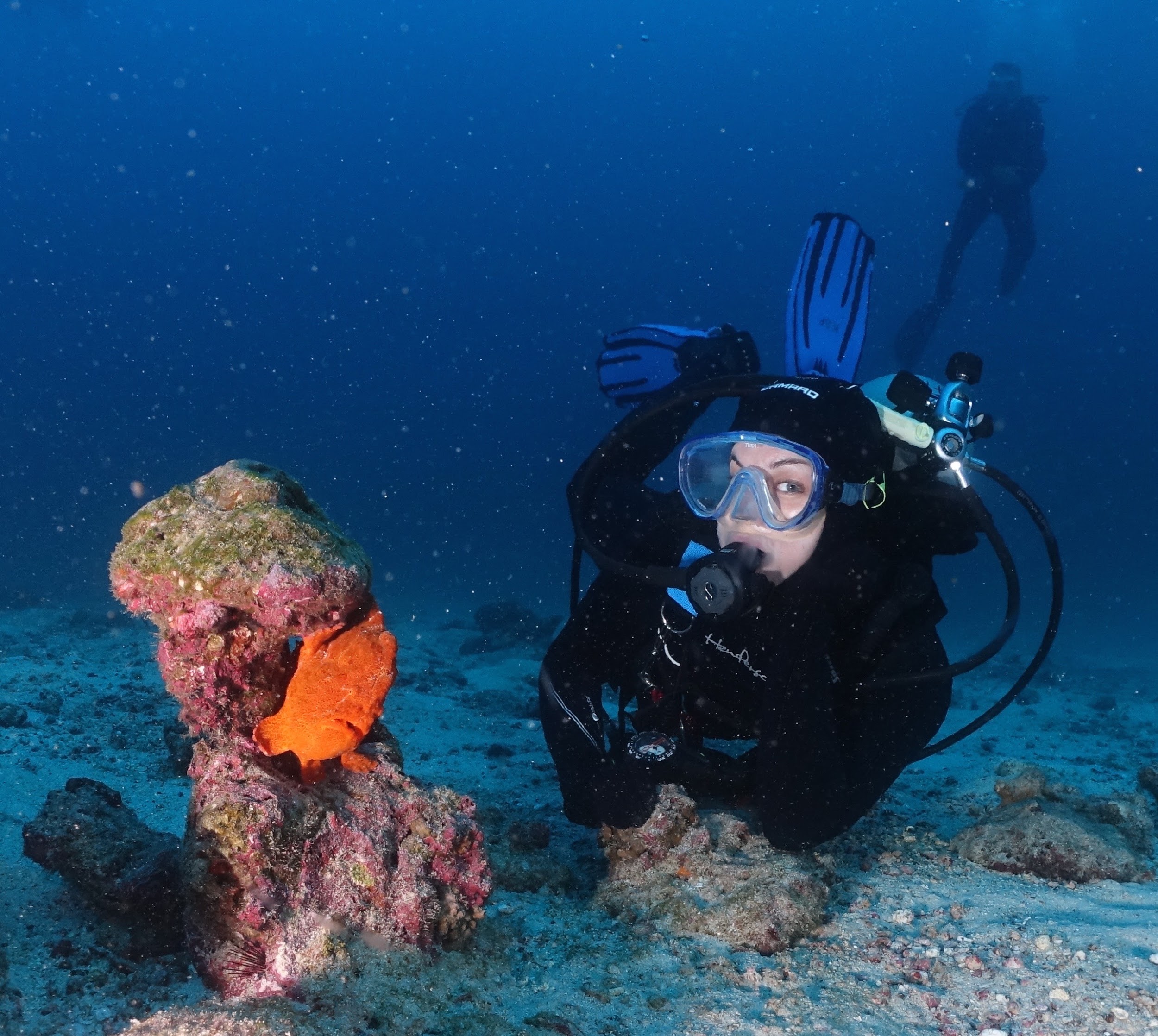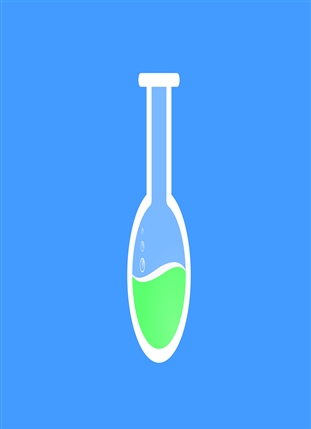2.4 – Gas Laws
During the seventeenth and especially eighteenth centuries, driven both by a desire to understand nature and a quest to make balloons in which they could fly (Figure 2.4.1), a number of scientists established the relationships between the macroscopic physical properties of gases, that is, pressure, volume, temperature, and amount of gas. Although their measurements were not precise by today’s standards, they were able to determine the mathematical relationships between pairs of these variables (e.g., pressure and temperature, pressure and volume) that hold for an ideal gas—a hypothetical construct that real gases approximate under certain conditions. Eventually, these individual laws were combined into a single equation—the ideal gas law—that relates gas quantities for gases and is quite accurate for low pressures and moderate temperatures. We will consider the key developments in individual relationships (for pedagogical reasons not quite in historical order), then put them together in the ideal gas law.

Figure 2.4.1. In 1783, the first (a) hydrogen-filled balloon flight, (b) manned hot air balloon flight, and (c) manned hydrogen-filled balloon flight occurred. When the hydrogen-filled balloon depicted in (a) landed, the frightened villagers of Gonesse reportedly destroyed it with pitchforks and knives. The launch of the latter was reportedly viewed by 400 000 people in Paris.
Pressure and Temperature: Amontons’s/Gay-Lussac’s Law
Imagine filling a rigid container attached to a pressure gauge with gas and then sealing the container so that no gas may escape. If the container is cooled, the gas inside likewise gets colder and its pressure is observed to decrease. Since the container is rigid and tightly sealed, both the volume and number of moles of gas remain constant. If we heat the sphere, the gas inside gets hotter (Figure 2.4.2) and the pressure increases.
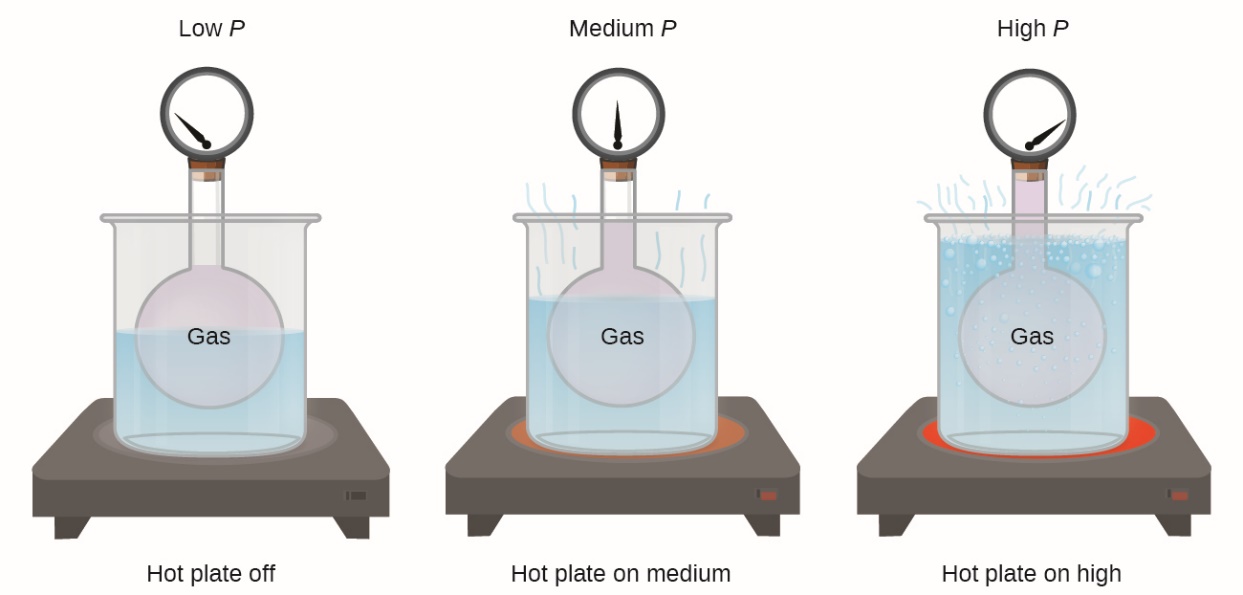
Figure 2.4.2. The effect of temperature on gas pressure: When the hot plate is off, the pressure of the gas in the sphere is relatively low. As the gas is heated, the pressure of the gas in the sphere increases.
This relationship between temperature and pressure is observed for any sample of gas confined to a constant volume. An example of experimental pressure-temperature graph is shown for a sample of air under these conditions in Figure 2.4.3. We find that temperature and pressure are linearly related, and if the temperature is on the Kelvin scale, then P and T are directly proportional (again, when volume and moles of gas are held constant); if the temperature on the Kelvin scale increases by a certain factor, the gas pressure increases by the same factor.
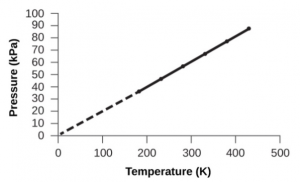
Figure 2.4.3. For a constant volume and amount of air, the pressure and temperature are directly proportional, provided the temperature is in kelvin. (Measurements cannot be made at lower temperatures because of the condensation of the gas.) When this line is extrapolated to lower pressures, it reaches a pressure of 0 at –273 °C, which is 0 on the Kelvin scale and the lowest possible temperature, called absolute zero.
Guillaume Amontons was the first to empirically establish the relationship between the pressure and the temperature of a gas (~1700), and Joseph Louis Gay-Lussac determined the relationship more precisely (~1800). Because of this, the P – T relationship for gases is known as either Amontons’s law or Gay-Lussac’s law. Under either name, it states that the pressure of a given amount of gas is directly proportional to its temperature on the Kelvin scale when the volume is held constant. Mathematically, this can be written:
P ∝ T
where the symbol µ means “proportional to”. Alternatively, the proportionality symbol may be converted to an equation by introducing k, a proportionality constant that depends on the identity, amount, and volume of the gas:
𝑃=𝑘 × 𝑇
Rearranging this equation indicates that for a confined, constant volume of gas, the ratio of P/T is equal to a constant value: ![]()
If the gas is initially in Condition 1 (i.e. at pressure P1 and temperature T1) and then changes to Condition 2 (i.e. at pressure P2 and temperature T2) we can derive the following equality:
![]()
Therefore, for a fixed amount of gas at constant volume (i.e. n = constant, V = constant), we can reduce this to: 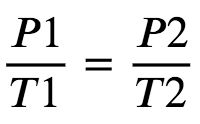
Note that the temperatures must be in kelvin for any gas law calculations…
Example 2.4.1 – Predicting Change in Pressure with Temperature
A can of hair spray is used until it is empty except for the propellant,
isobutane gas.
(a) On the can is the warning “Store only at temperatures below 120 °F (48.8 °C). Do not incinerate.” Why?
(b) The gas in the can is initially at 24 °C and 360 kPa, and the can has a volume of 350 mL. If the can is left in a car that reaches 50 °C on a hot day, what is the new pressure in the can?
Solution
(a) The can contains an amount of isobutane gas at a constant volume, so if the temperature is increased by heating, the pressure will increase proportionately. High temperature could lead to high pressure, causing the can to burst. (Also, isobutane is combustible, so incineration could cause the can to explode.)
(b) We are looking for a pressure change due to a temperature change at constant volume, so we will use Amontons’s/Gay-Lussac’s law. Taking P1 and T1 as the initial values, T2 as the temperature where the pressure is unknown and P2 as the unknown pressure, and converting °C to K, we have:
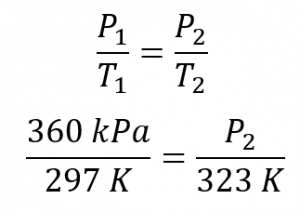
Rearranging and solving gives:

Check Your Learning 2.4.1 – Predicting Change in Pressure with Temperature
A sample of nitrogen, N2, occupies 45.0 mL at 27 °C and 600 Torr. What pressure will it have if cooled to –73 °C while the volume remains constant?
Answer
400 Torr
To see Amonton’s/Gay-Lussac’s law in action, check out this video.
Volume and Temperature: Charles’s Law
If we fill a balloon with air and seal it, the balloon contains a specific amount of air at atmospheric pressure, let’s say 1 atm. If we put the balloon in a refrigerator, the gas inside gets cold and the balloon shrinks (although both the amount of gas and its pressure remain constant). If we make the balloon very cold, it will shrink a great deal, and it expands again when it warms up. Check out this video to see it in action.
These examples of the effect of temperature on the volume of a given amount of a confined gas at constant pressure are true in general: The volume increases as the temperature increases, and decreases as the temperature decreases. Volume-temperature data for a 1-mole sample of methane gas at 1 atm are graphed in Figure 2.4.4.
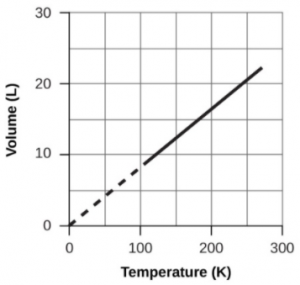
Figure 2.4.4. The volume and temperature are linearly related for 1 mole of methane gas at a constant pressure of 1 atm. If the temperature is in kelvin, volume and temperature are directly proportional. The line stops at 111 K because methane liquefies at this temperature; when extrapolated, it intersects the graph’s origin, representing a temperature of absolute zero.
The relationship between the volume and temperature of a given amount of gas at constant pressure is known as Charles’s law in recognition of the French scientist and balloon flight pioneer Jacques Alexandre César Charles. Charles’s law states that the volume of a given amount of gas is directly proportional to its temperature on the Kelvin scale when the pressure is held constant.
Mathematically, this can be written as:
V ∝ T
Again, the proportionality symbol may be converted to an equal sign by introducing a proportionality constant that depends on the identity, amount, and pressure of the gas:
𝑉=𝑘 × 𝑇
Rearranging this equation indicates that, at constant pressure, the ratio of V/T is equal to a constant value:
![]()
As seen with the pressure-temperature relationship at two different conditions, we can derive the following equality:![]()
Therefore, for a fixed amount of gas at constant pressure (i.e. n = constant, P = constant), we can reduce this to:
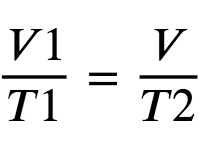
The above equation is a convenient form of Charles’ Law. Again, note that the temperatures provided must be in Kelvin.
Example 2.4.2 – Predicting Change in Volume with Temperature
A sample of carbon dioxide, CO2, occupies 0.300 L at 10 °C and 750 Torr. What volume will the gas have at 30 °C and 750 Torr?
Solution
Because we are looking for the volume change caused by a temperature change at constant pressure, this is a job for Charles’s law. Taking V1 and T1 as the initial values, T2 as the temperature at which the volume is unknown and V2 as the unknown volume, and converting °C into K we have:
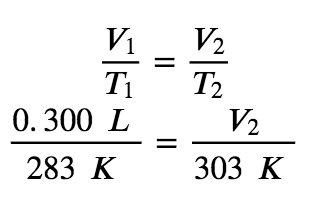
Rearranging and solving gives:

This answer supports our expectation from Charles’s law, namely, that raising the gas temperature (from 283 K to 303 K) at a constant pressure will yield an increase in its volume (from 0.300 L to 0.321 L).
Check Your Learning 2.4.2 – Predicting Change in Volume with Temperature
A sample of oxygen, O2, occupies 32.2 mL at 30 °C and 452 mmHg. What
volume will it occupy at –70 °C and the same pressure?
Answer
21.6 mL
Example 2.4.3 – Measuring Temperature with a Volume Change
Temperature is sometimes measured with a gas thermometer by observing the change in the volume of the gas as the temperature changes at constant pressure. The hydrogen in a particular hydrogen gas thermometer has a volume of 150.0 cm3 when immersed in a mixture of ice and water (0.00 °C). When immersed in boiling liquid ammonia, the volume of the hydrogen, at the same pressure, is 131.7 cm3. Find the temperature of boiling ammonia on the kelvin and Celsius scales.
Solution
A volume change caused by a temperature change at constant pressure means we should use Charles’s law. Taking V1 and T1 as the initial values, T2 as the temperature at which the volume is unknown and V2 as the unknown volume, and converting °C into K we have:
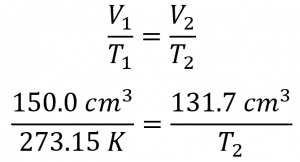
Rearrangement gives:

Subtracting 273.15 from 239.8 K, we find that the temperature of the boiling ammonia on the Celsius scale is –33.4 °C.
Check Your Learning 2.4.3 – Measuring Temperature with a Volume Change
What is the volume of a sample of ethane at 467 K and 1.1 atm if it occupies
405 mL at 298 K and 1.1 atm?
Answer
635 mL
Volume and Pressure: Boyle’s Law
If we partially fill an airtight syringe with air, the syringe contains a specific amount of air at constant temperature, say 25 °C. If we slowly push in the plunger while keeping temperature constant, the gas in the syringe is compressed into a smaller volume and its pressure increases; if we pull out the plunger, the volume increases and the pressure decreases. This example of the effect of volume on the pressure of a given amount of a confined gas is true in general. Decreasing the volume of a contained gas will increase its pressure, and increasing its volume will decrease its pressure. In fact, if the volume increases by a certain factor, the pressure decreases by the same factor, and vice versa. Volume-pressure data for an air sample at room temperature are graphed in Figure 2.4.5.
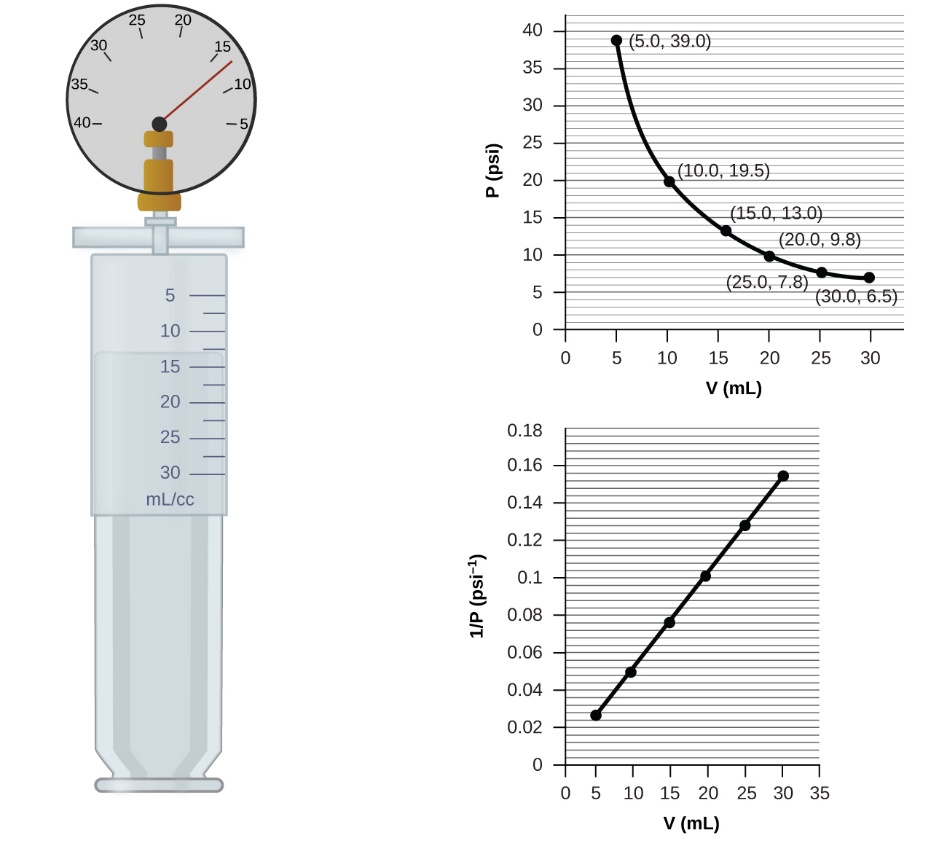
Figure 2.4.5. When a gas occupies a smaller volume, it exerts a higher pressure; when it occupies a larger volume, it exerts a lower pressure (assuming the amount of gas and the temperature do not change). Since P and V are inversely proportional, a graph of 1/P vs. V is linear.
Unlike the P–T and V–T relationships, pressure and volume are not directly proportional to each other. Instead, P and V exhibit inverse proportionality, where increasing the pressure results in a decrease of the volume of the gas (and vice-versa):

Introducing the proportionality constant, k, as shown previously, yields:

Graphically, this relationship is shown by the straight line that results when plotting the inverse of the pressure (1/P) versus the volume (V), or the inverse of volume (1/V) versus the pressure (P). Graphs with curved lines are difficult to read accurately at low or high values of the variables, and they are more difficult to use in fitting theoretical equations and parameters to experimental data. For those reasons, scientists often try to find a way to “linearize” their data. If we plot P versus V, we obtain a hyperbola (see Figure 2.4.6.).
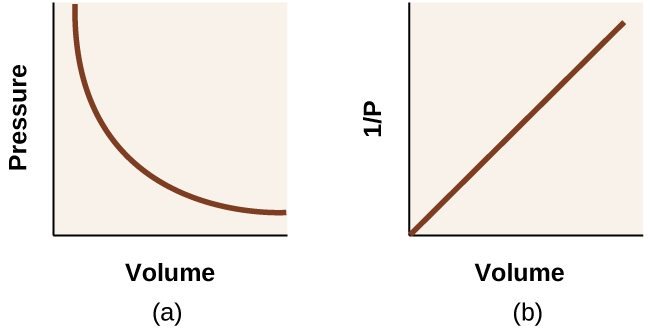
Figure 2.4.6. The relationship between pressure and volume is inversely proportional. (a) The graph of P vs. V is a hyperbola, whereas (b) the graph of (1/P) vs. V is linear.
Rearranging the P–V equation indicates that, at constant temperature, the product of P times V is equal to a constant value:
![]()
As seen with the previous relationships under initial and final conditions, we can derive the following equality:
![]()
Therefore, for a fixed amount of gas at constant temperature (i.e. n = constant, T = constant), we obtain a convenient form of Boyles Law:
![]()
The relationship between the volume and pressure of a given amount of gas at constant temperature was first published by the English natural philosopher Robert Boyle over 300 years ago. It is summarized in the statement now known as Boyle’s law: The volume of a given amount of gas held at constant temperature is inversely proportional to the pressure under which it is measured. Check out this experiment to learn more about Boyle’s law.
Example 2.4.4 – Volume of a Gas Sample
A sample of gas is placed in sealed container of variable volume. The gas has an initial volume of 15.0 mL at a pressure of 0.500 bar. The gas is compressed at constant temperature to a final volume of 7.5 mL. Determine the final pressure of the gas.
Solution
From Boyle’s law, we know that the product of pressure and volume (PV) for a given sample of gas at a constant temperature is always equal to the same value. Therefore, we can apply the above equation:

This final pressure makes total sense: notice that that final volume (7.5 mL) is exactly half of the initial volume (15.0 mL). Since the volume of the container has been halved, the pressure of the gas has doubled, due to the inverse relationship!
Check Your Learning 2.4.4 – Volume of a Gas Sample
At sea level, a 435 L balloon is filled with air to an initial pressure of 101.4 kPa. The balloon rises 100 m in the air to a pressure of 98.3 kPa. What is the change in the volume of the balloon, in litres? You may assume the temperature remains constant.
Answer
It increases by 13.7 L
Breathing and Boyle’s Law
What do you do about 20 times per minute for your whole life, without break, and often without even being aware of it? The answer, of course, is respiration, or breathing. How does it work? It turns out that the gas laws apply here. Your lungs take in gas that your body needs (oxygen) and get rid of waste gas (carbon dioxide). Lungs are made of spongy, stretchy tissue that expands and contracts while you breathe. When you inhale, your diaphragm and intercostal muscles (the muscles between your ribs) contract, expanding your chest cavity and making your lung volume larger. The increase in volume leads to a decrease in pressure (Boyle’s law). This causes air to flow into the lungs (from high pressure to low pressure). When you exhale, the process reverses: Your diaphragm and rib muscles relax, your chest cavity contracts, and your lung volume decreases, causing the pressure to increase (Boyle’s law again), and air flows out of the lungs (from high pressure to low pressure). You then breathe in and out again, and again, repeating this Boyle’s law cycle for the rest of your life (Figure 2.4.7.).
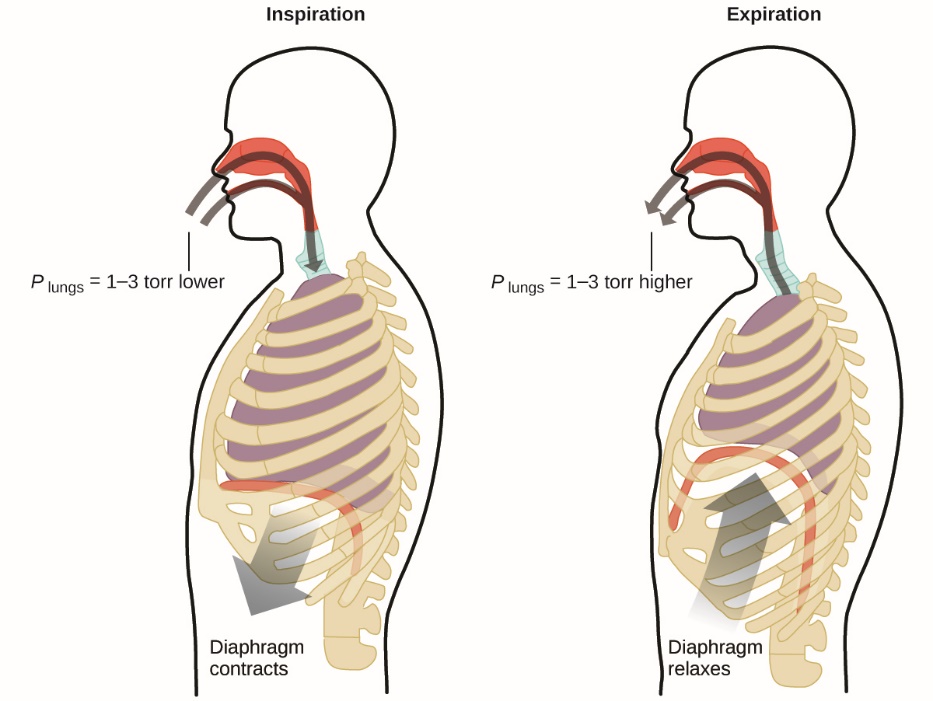
Figure 2.4.7. Breathing occurs because expanding and contracting lung volume creates small pressure differences between your lungs and your surroundings, causing air to be drawn into and forced out of your lungs.
Check out Chris Hadfield’s demonstration in a submarine to learn more about Boyle’s law.
Moles of Gas and Volume: Avogadro’s Law
The Italian scientist Amedeo Avogadro advanced a hypothesis in 1811 to account for the behavior of gases, stating that equal volumes of all gases, measured under the same conditions of temperature and pressure, contain the same number of molecules. Over time, this relationship was supported by many experimental observations as expressed by Avogadro’s law: For a confined gas, the volume (V) and number of moles (n) are directly proportional if the pressure and temperature both remain constant.
Following the same mathematical process as those shown above, we can derive an equation for Avogadro’s Law for a gas at constant pressure and temperature (i.e. P = constant, T = constant),:
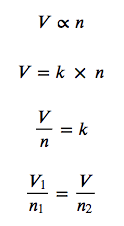
Mathematical relationships can also be determined for the other variable pairs, such as P versus n, and n versus T. Check out the following animation to see how the gas laws are affected by changes in pressure, temperature, moles of gas, and volume.
The Ideal Gas Law
To this point, four separate laws have been discussed that relate pressure, volume, temperature, and the number of moles of the gas:
- Boyle’s law: PV = constant at constant T and n
- Amontons’s/Gay-Lussac’s law: P/T = constant at constant V and n
- Charles’s law: V/T = constant at constant P and n
- Avogadro’s law: V/n = constant at constant P and T
Combining these four laws yields the ideal gas law, a relation between the pressure, volume, temperature, and number of moles of a gas:
PV = nRT
where P is the pressure of a gas, V is its volume, n is the number of moles of the gas, T is its temperature on the Kelvin scale, and R is a constant called the ideal gas constant or the universal gas constant. The units used to express pressure, volume, and temperature will determine the proper form of the gas constant as required by dimensional analysis, the most commonly encountered values being 0.08206 L atm mol–1 K–1 and 8.314 kPa L mol–1 K–1. To see the gas constant expressed in different units, visit this site.
Gases whose properties of P, V, and T are accurately described by the ideal gas law (or the other gas laws) are said to exhibit ideal behavior or to approximate the traits of an ideal gas. An ideal gas is a hypothetical construct that may be used along with kinetic molecular theory to effectively explain the gas laws as will be described in a later module of this chapter. Although all the calculations presented in this module assume ideal behavior, this assumption is only reasonable for gases under conditions of relatively low pressure and high temperature. In the final module of this chapter, a modified gas law will be introduced that accounts for the non-ideal behavior observed for many gases at relatively high pressures and low temperatures.
The ideal gas equation contains five terms, the gas constant R and the variable properties P, V, n, and T. Specifying any four of these terms will permit use of the ideal gas law to calculate the fifth term as demonstrated in the following example exercises.
Example 2.4.5 – Using the Ideal Gas Law
Methane, CH4, is being considered for use as an alternative automotive fuel to replace gasoline. One gallon of gasoline could be replaced by 655 g of CH4. What is the volume of this much methane at 25 °C and 745 Torr?
Solution
We must rearrange PV = nRT to solve for V :
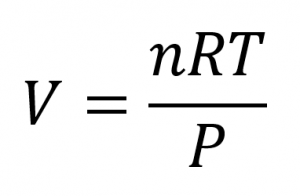
If we choose to use R = 0.08206 L atm mol–1 K–1, then the amount must be in moles, temperature must be in kelvin, and pressure must be in atm.
Converting into the correct units and solving:


It would require 1020 L of gaseous methane at about 1 atm of pressure to replace 1 gallon of gasoline. It requires a large container to hold enough methane at 1 atm to replace several gallons of gasoline.
Check Your Learning 2.4.5 – Using the Ideal Gas Law
Calculate the pressure in bar of 2520 moles of hydrogen gas stored at 27 °C in the 180-L storage tank of a modern hydrogen-powered car.
Answer
350 bar
We can rearrange the ideal gas law to isolate the ideal gas constant:
 As seen previously, we may apply two different sets of initial and final conditions, and a useful mathematical relationship, sometimes called the combined gas law, is obtained
As seen previously, we may apply two different sets of initial and final conditions, and a useful mathematical relationship, sometimes called the combined gas law, is obtained

You should be able to note that, if any of the variables is held constant, this general equation can be simplified to the relationships established earlier in this chapter. For example, in a case where the amount of gas (n) and its temperature (T) are constant: 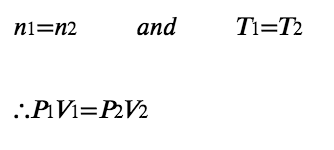
In other words, the equation reduces to Boyle’s Law!
Example 2.4.6 – Using the Combined Gas Law
When filled with air, a typical scuba tank with a volume of 13.2 L has a pressure of 153 atm (Figure 2.4.8.). If the water temperature is 27 °C, how many liters of air will such a tank provide to a diver’s lungs at a depth of approximately 21 m in the ocean where the pressure is 3.13 atm?
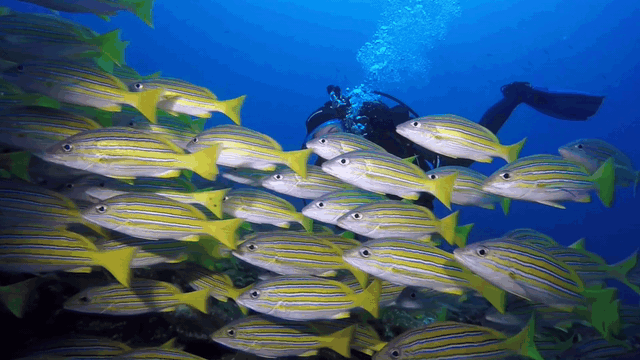
Figure 2.4.8. Scuba divers use compressed air to breathe while underwater. (credit: KS Focsaneanu)
Solution
Letting 1 represent the air in the scuba tank and 2 represent the air in the lungs, and noting that body temperature (the temperature the air will be in the lungs) is 37 °C, we have:

Solving for V2:

(Note: Be advised that this particular example is one in which the assumption of ideal gas behavior is not very reasonable, since it involves gases at relatively high pressures and low temperatures. Despite this limitation, the calculated volume can be viewed as a good “ballpark” estimate.)
Check Your Learning 2.4.6 – Using the Combined Gas Law
A sample of ammonia is found to occupy 0.250 L under laboratory conditions of 27 °C and 0.850 atm. Find the volume of this sample at 0 °C and 1.00 atm.
Answer
0.193 L
|
The Interdependence Between Ocean Depth and Pressure in SCUBA Diving |
|
When scuba diving, divers must understand how pressure affects a number of issues related to their comfort and safety.
Figure 2.4.9. Scuba divers must be constantly aware of buoyancy, pressure equalization, and the amount of time they spend underwater, to avoid the risks associated with pressurized gases in the body. Giant frogfish, Cocas Islands, Costa Rica (credit: KS Focsaneanu). Pressure increases with ocean depth, and the pressure changes most rapidly as divers reach the surface. The pressure a diver experiences is the sum of all pressures above the diver (from the water and the air). Most pressure measurements are given in units of atmospheres, expressed as “atmospheres absolute” or ATA in the diving community: Every 10 m of salt water represents 1 ATA of pressure in addition to 1 ATA of pressure from the atmosphere at sea level. As a diver descends, the increase in pressure causes the body’s air pockets in the ears and lungs to compress; on the ascent, the decrease in pressure causes these air pockets to expand, potentially rupturing eardrums or bursting the lungs. Divers must therefore undergo equalization by adding air to body airspaces on the descent by breathing normally and adding air to the mask by breathing out of the nose or adding air to the ears and sinuses by equalization techniques; the corollary is also true on ascent, divers must release air from the body to maintain equalization. Buoyancy, or the ability to control whether a diver sinks or floats, is controlled by the buoyancy compensator (BCD). If a diver is ascending, the air in his BCD expands because of lower pressure according to Boyle’s law (decreasing the pressure of gases increases the volume). The expanding air increases the buoyancy of the diver, and she or he begins to ascend. The diver must vent air from the BCD or risk an uncontrolled ascent that could rupture the lungs. In descending, the increased pressure causes the air in the BCD to compress and the diver sinks much more quickly; the diver must add air to the BCD or risk an uncontrolled descent, facing much higher pressures near the ocean floor. The pressure also impacts how long a diver can stay underwater before ascending. The deeper a diver dives, the more compressed the air that is breathed because of increased pressure: If a diver dives 10 m, the pressure is 2 ATA and the air would be compressed to one-half of its original volume. The diver uses up available air twice as fast as at the surface. |
Standard Conditions of Temperature and Pressure
We have seen that the volume of a given quantity of gas and the number of molecules (moles) in a given volume of gas vary with changes in pressure and temperature. Chemists sometimes make comparisons against a standard temperature and pressure (STP) for reporting properties of gases: 273.15 K and 1 bar (100 kPa). At STP, one mole of an ideal gas has a volume of about 22.7 L—this is referred to as the standard molar volume (Figure 2.4.10).
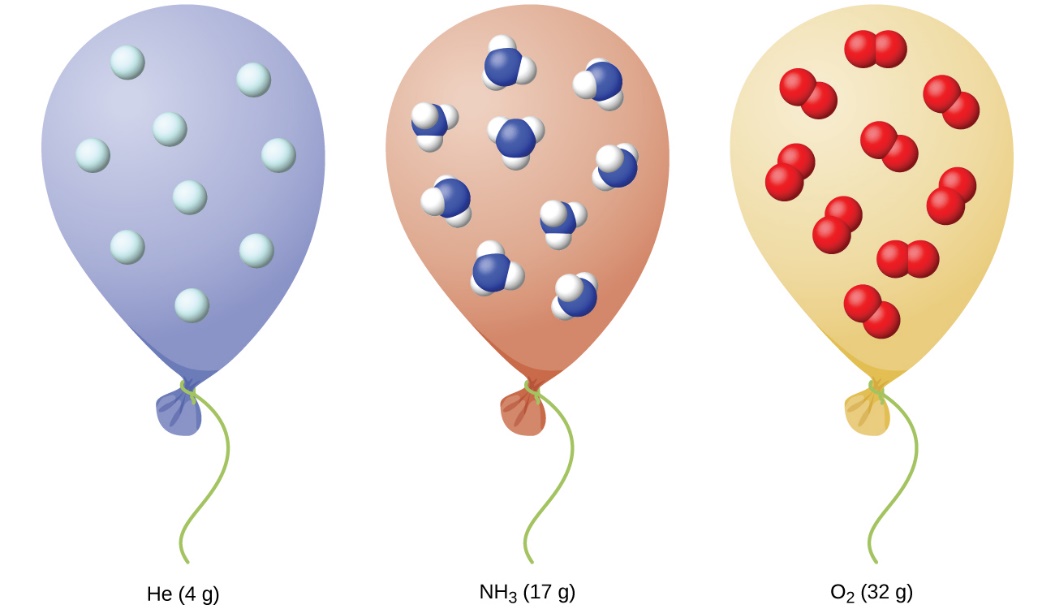
Figure 2.4.10. Since the number of moles in a given volume of gas varies with pressure and temperature changes, chemists use standard temperature and pressure (273.15 K and 1 bar or 100 kPa) to report properties of gases.
|
CHM1311 Laboratory | Experiment #1: Verification of Gas Laws |
|
Purpose Before you get started with your first experiment of the course, you’ll first organize yourself by getting a lab partner, meeting your TA (lab demonstrator), and performing a locker examination of laboratory equipment at your disposal. You’ll also be familiarizing yourself with the laboratory component of the general chemistry course and all logistical matters pertaining to it. This information will be presented to you briefly on your first day and is all available on Brightspace in the CHM1311 General Chemistry Laboratory course platform. For the actual experiment, you’ll be validating two of the gas laws you saw in this section: Boyle’s Law: at a given constant temperature, the pressure of a certain amount of gas is inversely proportional to its volume P ∝ 1/V Charles’ Law: under constant pressure conditions, the volume of a particular amount of gas is directly proportional to its temperature V ∝ T Principles Charles’ Law Boyle’s Law Ideal gas behaviour Determination of experimental parameters Validation of experimental results Safety Precautions Wear appropriate personal protective equipment (PPE) at all times in the laboratory setting – this includes your lab coat and safety goggles/glasses. You’ll be working with hot objects, including the hot plate, boiling water bath, and heated Erlenmeyer flask during the first part of validating Charles’ Law. Please take extra precaution when handling such objects and avoid direct contact with them. Equipment such as tongs and clamps are at your disposal to use. Things to Consider The notion and properties of an ideal gas differ from those of a real gas (see sections 2.6 and 2.8 on the differing properties of ideal and real gases). Note that the two gas laws you’ll be investigating assume that air behaves as an ideal gas, since these two laws constitute the ideal gas law. Keep this assumption in mind when you perform your data analysis and discuss your findings in your report. When thinking about sources of error for validating gas laws, consider the existence of other gas variables, what they are, and how they may or may not have affected your results. Charles’ Law
Boyle’s Law
Reference Venkateswaran, R. General Chemistry – Laboratory Manual – CHM 1301/1311. |
Questions
★ Questions
1. Determine the volume of 1 mol of CH4 gas at 150 K and 1 atm, using Figure 2.4.4.
2. Determine the pressure of the gas in the syringe shown in Figure 2.4.5. when its volume is 12.5 mL, using:
(a) the appropriate graph
(b) Boyle’s law
3. A spray can is used until it is empty except for the propellant gas, which has a pressure of 1344 Torr at 23 °C. If the can is thrown into a fire (T = 475 °C), what will be the pressure in the hot can?
4. A 2.50 L volume of hydrogen measured at –196 °C is warmed to 100 °C. Calculate the volume of the gas at the higher temperature, assuming no change in pressure.
5. A weather balloon contains 8.80 moles of helium at a pressure of 0.992 atm and a temperature of 25 °C at ground level. What is the volume of the balloon under these conditions?
6. Iodine, I2, is a solid at room temperature but sublimes (converts from a solid into a gas) when warmed. What is the temperature in a 73.3 mL bulb that contains 0.292 g of I2 vapor at a pressure of 0.462 atm?
7. How many grams of gas are present in each of the following cases?
(a) 0.100 L of CO2 at 307 Torr and 26 °C
(b) 8.75 L of C2H4, at 378.3 kPa and 483 K
(c) 221 mL of Ar at 0.23 Torr and –54 °C
★★ Questions
8. A high altitude balloon is filled with 1.41 × 104 L of hydrogen at a temperature of 21 °C and a pressure of 745 Torr. What is the volume of the balloon at a height of 20 km, where the temperature is –48 °C and the pressure is 63.1 Torr?
9. A cylinder of medical oxygen has a volume of 35.4 L, and contains O2 at a pressure of 151 atm and a temperature of 25 °C. What volume of O2 does this correspond to at normal body conditions, that is, 1 atm and 37 °C?
10. A 20.0 L cylinder containing 11.34 kg of butane, C4H10, was opened to the atmosphere. Calculate the mass of the gas remaining in the cylinder if it were opened and the gas escaped until the pressure in the cylinder was equal to the atmospheric pressure, 0.983 atm, and a temperature of 27 °C.
11. For a given amount of gas showing ideal behavior, draw labeled graphs of:
(a) the variation of P with V
(b) the variation of V with T
(c) the variation of P with T
(d.) the variation of 1/P with V
12. A liter of methane gas, CH4, at STP contains more atoms of hydrogen than does a liter of pure hydrogen gas, H2, at STP. Using Avogadro’s law as a starting point, explain why.
13. If the temperature of a fixed amount of a gas is doubled at constant volume, what happens to the pressure?
14. If the volume of a fixed amount of a gas is tripled at constant temperature, what happens to the pressure?
Answers
1. About 12.2 L
2. (a) 15.38 psi, (b) 15.6 psi
3. 3.40 × 103 Torr
4. 12.1 L
5. 217 L
6. 358.5 K
7. (a) 7.24 × 10–2 g; (b) 23.1 g; (c) 1.5 × 10–4 g
8. 1.274 x 105 L
9. 5561 L
10. 46.4 g
11. 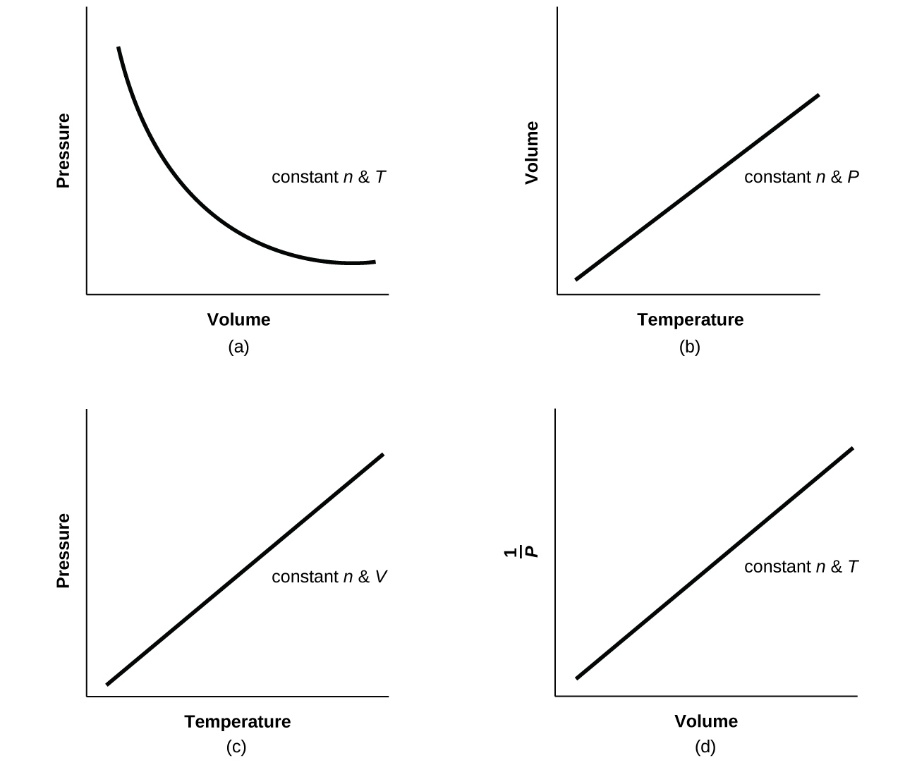
12. One mole of gas is equivalent to 22.4 Liters at STP. Hence there are twice as many H atoms in CH4 than there are in H2, and as a result there are more H atoms in the CH4 sample.
13. P1/T1 = P2/T2, hence P1 = T1(P2)/2(T1), 2 × P1 = P2, hence the pressure doubles.
14. The pressure decreases by a factor of 3.
Pressure of a given number of moles of gas is directly proportional to its kelvin temperature when the volume is held constant
Pressure of a given number of moles of gas is directly proportional to its kelvin temperature when the volume is held constant
Volume of a given number of moles of gas is directly proportional to its kelvin temperature when the pressure is held constant
Volume of a given number of moles of gas held at constant temperature is inversely proportional to the pressure under which it is measured
Volume of a gas at constant temperature and pressure is proportional to the number of gas molecules
Relation between the pressure, volume, amount, and temperature of a gas under conditions derived by combination of the simple gas laws
Constant derived from the ideal gas equation R = 0.08206 L atm mol–1 K–1 or 8.314 L kPa mol–1 K–1
Hypothetical gas whose physical properties are perfectly described by the gas laws; it conforms exactly to the tenets of the kinetic molecular theory
Volume of 1 mole of gas at STP, approximately 22.7 L for gases behaving ideally

